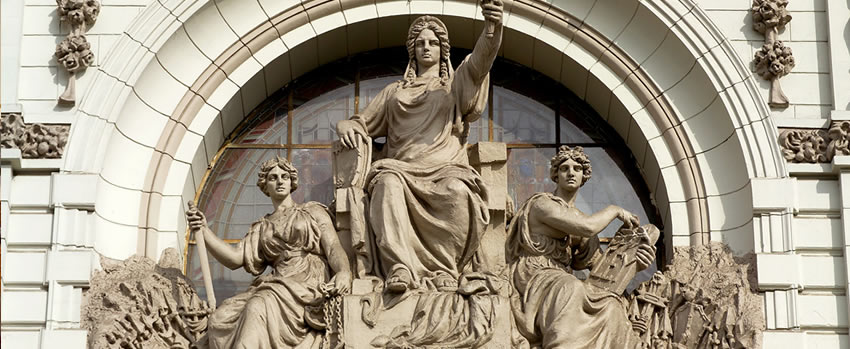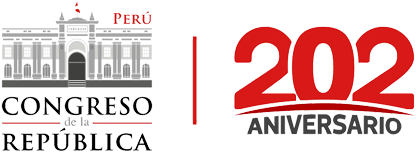“Año de la recuperación y consolidación de la economía peruana”
“Year of the Recovery and Consolidation of the Peruvian Economy”
“Jahr des Aufswungs und der Konsolidierung der peruanischen Wirtschaft”
“Année de la reprise et de la consolidation de l'économie péruvienne”
“Peru mamallaqtapaq qullqi kausarichiypaq, sinchiyachina wata”
SECRETARIAT GENERAL

The Secretariat General is the highest unit of parliamentary service in Congress. It is led by an official called Secretary General, who reports to the President of Congress about the smooth running of Congress, staff and offices of parliamentary service. Within his inherent duties or by delegation, he is in charge of supervising and controlling all legislative activities aimed at the preparation, assistance, support the basic and functional assignments of Members of Congress.
The Secretary General is the legal representative of the congressional administration, with disciplinary authority over all staff in Congress. By the President’s delegation, and subject to inform thereof, the Secretary General may conclude contracts for the smooth operation of Congress and the parliamentary service. He is appointed and removed from office by the Executive Council.
The Parliamentary Service Statute contains the powers and duties of the Secretary General as well as those of the parliamentary units and staff. He may be removed from office on resignation, the loss of his condition of public servant, early or mandatory retirement, and the inability to hold office, dismissal or revocation of his appointment. In case of absence or temporary inability, the Secretary General shall be substituted by the Parliamentary General Director.
(Amended article of Legislative Resolution No. 025-2003-CR, published on 21 of February of 2004)
-----------------------------------------------------------------------------------------------------------
NOTE: Congress Legislative Resolution No. 025-2003-CR, published on February 21, 2004, amending this article, includes the following Single Transitory Provision:
“Single Provision: During the term between the adoption of this amendment and the adoption of the Statute of the Parliamentary Service, articles 28º, 38º, 40º and 41º, repealed by this resolution, are still in force only with regards to the powers attributed to the Secretary-General, the General Parliamentary Director and the General Manager.”
-----------------------------------------------------------------------------------------------------------
Brief History of the Secretary-General’s Office
In the history of mankind, “the designated” might be considered as the oldest predecessor of the official currently known as the Secretary-General. At the time of the first clans mentioned in the Old Testament, the “designated” was chosen by the clan leaders or town chiefs, and should be enough qualified and experienced to carry out different functions: from ruling skills in order to manage household and financial matters as well as relations with other peoples, to ideal physical conditions to face war conflicts.
Later on, at Caesar’s Rome, we find the “pater familia”, a member of the Roman gens, who ran the home, economic and financial affairs and took care of the offspring education. It was a distinguished, wise, poetic, traveling, and skillful man with abilities in physical activities and good at handling weapons.
In the Middle Ages, the feudal lord chose among the noblemen someone who might be able to manage his castle, lands, collection of taxes and might take care of children’s education. As bourgeoisie and cities arose, big families relied upon those who had artistic skills or deep knowledge of the arts and sciences, and were responsible for the education and administration of the family.
In the period from the Medieval to Modern Age, we can observe the transition of this family administrator, to call him somehow, into a public official. It must be highlighted that during the Medieval times the Latin term “officium” designated any person who held a public office.
Upon the establishment of Nation-States, the figure of this wise man definitively became institutional through a technical secretariat, made up by advisers and experts in public administration and directed by a Secretariat General, headed by an outstanding professional, carefully chosen among the best qualified members of a science academy or a higher learning institution.
This office came to Peru, obviously with the Spanish institutions, and the one who held this office was called Royal Officer. As independence was obtained, the office was kept in the public administration, both in Executive and Legislative Branches, but changing to Secretary General. Hence, this denomination was not exclusive for the Congress. However, it is in Parliament where it has taken on a traditional character which lasts till now.
Etymologically, “Oficial Mayor”, Secretary-General in Spanish, is made up of two words “Oficial” (officer) and “Mayor” (Senior). Oficial in Spanish comes from the Latin “Officium”, which in the Middle Ages designated anyone who held a public office. And “Senior” (Mayor), together with the previous one, meant in this case “principal”, “first or highest in rank” or “chief”. In order to ensure the congressional operation, the first representatives appointed the first civil servants, headed by the first Secretary-General, Mr. Manuel Herrera y Oricaín, whose appointment was approved during the plenary sittings of October 12, 1822.
Since the beginning of Peruvian parliamentary history, the Secretary-General has been a high-rank, technical, non-political officer. His administration, despite the multiple variations of political activities, has lasted for long periods, thus fostering institutional continuity in the work of the Legislative Branch. For instance: Juan Martin Garro (1827-1849) lasted 22 years in office; Ricardo Rios (1911-1945) 34 years in office and Ismael Echegaray (1950-1972) 22 years in office. Hence, very few people have had the honor to hold this office.
Traditionally, the Congress of the Republic was made up by two Chambers: the Senate and the House of Deputies. Pursuant to the Standing Rules and Orders of the Chambers, when the Congress assembled in the House of Deputies, the Secretary General was also the Secretary of the lower House. Likewise, the Secretary General of the lower House was also the Secretary General of the Congress of the Republic.
List of Secretaries-General of the Congress of the Republic of Peru
- Manuel de Herrera y Oricaín, (1822-1825) (7)
- José Martín Garro, (1827- 1849) (8)
- José María Sánchez de la Barra, (1839)
- Juan Celestino Cavero y Celis, (1849-1858)
- José María Hernando (1858-1881) (9)
- Juan Fernando Erasmo Gazzani García del Real , (1881-1884 y 1889-1895)
- Ricardo Aranda Vargas Machuca, (1894-1895)
- Armando José Manuel Vélez Mendoza, (1895-1911)
- Ricardo Ríos Fajardo, (1908, 1911-1945)
- Manuel Pérez Cartier, (1945-1948)
- José Carlos Llosa González Pavón, (1948-1949)
- Enrique Carrillo Smith, (1949)
- Eugenio Raygada de la Flor, (1949-1950) (10)
- Ismael Echegaray Correa, (1950-1972)
- Luis Chacón Saavedra, (1978-1991)
- Delfín Sotelo Mejía, (1991-1992)
- José Cevasco Piedra, (1993- 2002)
- José Elice Navarro, (2002 - 2003)
- César Delgado Guembes (04/06/2003 - 15/12/2003)
- José Elice Navarro, (16/12/2003 - 31/07/ 2006)
- José Cevasco Piedra, (02/08/2006 - 19/06/2007)
- José Antonio Abanto Valdivieso (19/06/2007 - 04/08/2011)
- Giuliana Zenaida Lastres Blanco (4/08/2011 – 25/07/2012)
- Javier Adolfo Ángeles Illmann (25/07/2012 – 27/07/2015)
- Hugo Fernando Rovira Zagal (27/07/2015 - 09/08/2016)
- José Cevasco Piedra, (10/08/2016 - 12/08/2018)
- José Antonio Abanto Valdivieso (13/08/2018 - 18/10/2018)
- Gianmarco Paz Mendoza (19/10/2018 - 08/08/2019)
- Giovanni Carlo Antonio Forno Flórez (08/08/2019 - 21/05/2020)
- Javier Adolfo Ángeles Illman (21/05/2020 - to date)
______________
(7) Attorney of the General Directorate of Census.
(8) Professor of Mathematics at San Marcos University.
(9) He died defending the city of Lima, at the Battle of Miraflores, fighting as a private soldier in Battalion No. 6 of the Reserve Army of Lima, on January 15, 1881, during the war against Chile. He was a Juris Doctor.
(10) Only administratively at 1950-1951.
(11) Only legislatively at 1950-1951.
SOURCE:
Technical Unit of the Secretariat General of Congress





